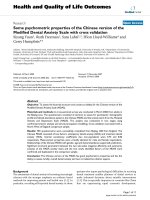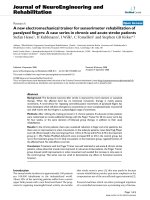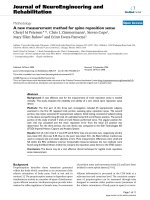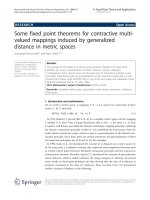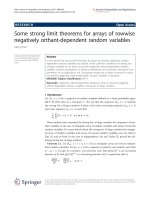Báo cáo hóa học: " Some new nonlinear retarded sum-difference inequalities with applications" doc
Bạn đang xem bản rút gọn của tài liệu. Xem và tải ngay bản đầy đủ của tài liệu tại đây (274.73 KB, 11 trang )
RESEARC H Open Access
Some new nonlinear retarded sum-difference
inequalities with applications
Wu-Sheng Wang
1*
, Zizun Li
2
and Wing-Sum Cheung
3
* Correspondence: wang4896@126.
com
1
Department of Mathematics,
Hechi University, Guangxi, Yizhou
546300, People’s Republic of China
Full list of author information is
available at the end of the article
Abstract
The main objective of this paper is to establish some new retarded nonlinear sum-
difference inequalities with two independent variables, which provide explicit
bounds on unknown functions. These inequalities given here can be used as handy
tools in the study of boundary value problems in partial difference equations.
2000 Mathematics Subject Classification: 26D10; 26D15; 26D20.
Keywords: sum-difference inequalities, boundary value problem
1 Introduction
Being important tools in the study of differential, integral, and integro-differential
equations, various generalizations of Gronwall inequality [1,2] and their applicat ions
have attracted great interests of many mathematicians (cf. [3-16], and the references
cited therein). Recently, Agarwal et al. [3] studied the inequality
u(t ) ≤ a(t)+
n
i=1
b
i
(t)
b
i
(
t
0
)
g
i
(t , s)w
i
(u(s))ds, t
0
≤ t < t
1
.
Cheung [17] investigated the inequality
u
p
(x, y) ≤ a +
p
p − q
b
1
(x)
b
1
(x
0
)
c
1
(y)
c
1
(y
0
)
g
1
(s, t)u
q
(s, t)dtds
+
p
p − q
b
2
(x)
b
2
(
x
0
)
c
2
(y)
c
2
(
y
0
)
g
2
(s, t)u
q
(s, t)ψ(u(s, t))dtds
.
Agarwal et al. [18] obtained explicit bounds to the solutions of the following retarded
integral inequalities:
Wang et al. Advances in Difference Equations 2011, 2011:41
/>© 2011 Wang et al; licensee Springer. This is an Open Access article distributed under the terms of the Creative Commons Attribution
License ( which permits unrestricted use, distribution, and reproduction in any medium,
provided the original work is properly cited.
ϕ(u(t)) ≤ c +
n
i=1
α
i
(
t
)
α
i
(t
0
)
u
q
(s)[f
i
(s)ϕ
u(s)
+ g
i
(s)]ds,
ϕ(u(t)) ≤ c +
n
i=1
α
i
(t)
α
i
(t
0
)
u
q
(s)[f
i
(s)ϕ
1
u(s)
+ g
i
(s)ϕ
2
logu(s)
]ds
,
ϕ(u(t)) ≤ c +
n
i=1
α
i
(t)
α
i
(
t
0
)
u
q
(s)[f
i
(s)L
s, u(s)
+ g
i
(s)u(s)]ds,
where c is a constant, and Chen et al. [19] did the same for the following ineq ual-
ities:
ψ(u(x, y)) ≤ c +
γ ( x)
γ ( x
0
)
δ(y)
δ(y
0
)
f (s, t)ϕ(u(s, t))dtds,
ψ(u(x, y)) ≤ c +
α(x)
α(x
0
)
β(y)
β(y
0
)
g(s, t)u(s, t)dtds
+
γ ( x)
γ ( x
0
)
δ(y)
δ(y
0
)
f (s, t)u(s, t)ϕ(u(s, t))dtds,
ψ(u(x, y)) ≤ c +
α(x)
α(x
0
)
β(y)
β(y
0
)
g(s, t)w(u(s, t))dtds
+
γ ( x)
γ
(
x
0
)
δ(y)
δ
(
y
0
)
f (s, t)w(u(s, t))ϕ(u(s, t))dtds
,
where c is a constant.
Along with the development of the theory of integral inequalities and the theory of
difference equations, more attent ions are drawn to some discrete versions of Gronwall
type inequalities (e.g., [20-22] for some early works). Some recent works can be found,
e.g., in [6,23-25] and some references therein. Found in [26], the unknown function u
in the fundamental form of sum-difference inequality
u
(n) ≤ a(n)+
n−1
s
=
0
f (s)u(s
)
can be estimated by
u
(n) ≤ a(n)
n−1
s
=
0
(1 + f (s)
)
.In[6],theinequalityoftwovari-
ables
u
2
(m, n) ≤ c
2
+
m−
1
s=m
0
n−
1
t=n
0
a(s, t)u(s, t)+
m−
1
s=m
0
n−
1
t=n
0
b(s, t)u(s, t)w
u(s, t)
Wang et al. Advances in Difference Equations 2011, 2011:41
/>Page 2 of 11
was discussed, and the result was generalized in [23] to the inequality
u
p
(m, n) ≤ c +
m−
1
s=m
0
n−
1
t=n
0
a(s, t)u
q
(s, t)+
m−
1
s=m
0
n−
1
t=n
0
b(s, t)u
q
(s, t)w
u(s, t)
.
In this paper, motivated mainly by the works of Cheung [17,23], Agarwal et al. [3,18],
and Chen et al. [19], we shall discuss upper bounds of the function u(m, n)satisfying
one of the following general sum-difference inequalities
ψ(u(m, n)) ≤ a(m, n)+b(m, n)
k
i=1
m−1
s=m
0
n−1
t=n
0
w
u(α
i
(s), β
i
(t))
[f
i
(s, t)ϕ
u(α
i
(s), β
i
(t))
+g
i
(
s, t
)
],
(1:1)
ψ(u(m, n)) ≤ a(m, n)+b(m, n)
k
i=1
m−1
s=m
0
n−1
t=n
0
w
u(α
i
(s), β
i
(t))
[f
i
(s, t)ϕ
1
u(α
i
(s), β
i
(t))
+g
i
(s, t)ϕ
2
logu(α
i
(s), β
i
(t))
],
(1:2)
ψ(u(m, n)) ≤ a(m, n)+b(m, n)
k
i=1
m−1
s=m
0
n−1
t=n
0
w
u(α
i
(s), β
i
(t))
[f
i
(s, t)L
s, t, u(α
i
(s), β
i
(t))
+g
i
(s, t)u
α
i
(s), β
i
(t)
],
(1:3)
for (m, n) Î [m
0
, m
1
) ∩ N
+
×[n
0
, n
1
) ∩ N
+
,wherea(m, n), b(m, n) are nonnegative
and nonde-creasing functions in each variable. Inequalities (1.1), (1.2), and (1.3) are the
discrete versions of Agarwal et al. [18] and Chen et al. [19]. They not only generalized
the forms with one variable into the ones with two variables but also extended the
constant ‘c’ out of integral into a function ‘a(m, n)’. These inequalities will play an
important part in the study on difference equation. To illustrate the action of their
inequalities, we also gave an example of boundary value problem in partial difference
equation.
2 Main result
Throughout this paper, k, m
0
, m
1
, n
0
, n
1
are fixed natural numbers. N
+
:= {1, 2, 3, . . .},
I := [m
0
, m
1
] ∩ N
+
, I
m
:= [m
0
, m] ∩ N
+
, J := [n
0
, n
1
] ∩ N
+
, J
n
:= [n
0
, n] ∩ N
+
, ℝ
+
:= [0,
∞). For functions s(m), z(m, n ), m, n Î N, their first-order (forward) differences are
defined by Δs(m)=s(m +1)-s(m), Δ
1
z(m, n)=z(m +1,n) -z(m, n)andΔ
2
z(m, n)=
z(m, n +1)-z(m, n). Obviously, the linear difference equation Δx(m)=b(m)with
initial conditi on x(m
0
) = 0 has solution
m−
1
s=m
0
b(s
)
. For convenience, in the sequel, we
define
m
0
−
1
s=m
0
b(s)=
0
. We make the following assumptions:
(H
1
) ψ Î C(ℝ
+
, ℝ
+
) is strictly increasing with ψ(0) = 0 and ψ (t) ® ∞ as t ® ∞;
(H
2
) a, b : I × J ® (0, ∞) are nondecreasing in each variable;
(H
3
) w, ,
1
,
2
Î C(ℝ
+
,ℝ
+
) are nondecreasing with w(0) > 0, (r)>0,
1
(r) > 0 and
2
(r) > 0 for r >0;
(H
4
) a
i
: I ® I and b
i
: J ® J are nondecreasing with a
i
(m) ≤ m and b
i
(n) ≤ n, i =1,2,
,k;
(H
5
) f
i
, g
i
: I × J ® ℝ
+
, i =1,2, ,k.
Theorem 1. Suppose (H
1
-H
5
) hold and u(m, n) is a nonnegative function on I × J
satisfying (1.1). Then, we have
Wang et al. Advances in Difference Equations 2011, 2011:41
/>Page 3 of 11
u
(m, n) ≤ ψ
−1
W
−1
−1
A(m, n)
(2:1)
for all
(m, n) ∈ I
M
1
× J
N
1
, where
W(r):=
r
1
ds
w(ψ
−1
(s))
for r > 0; W(0) := lim
r→0
+
W(r)
,
(2:2)
(r):=
r
1
ds
ϕ(ψ
−1
(W
−1
(s)))
for r > 0; (0) := lim
r→0
+
(r)
,
(2:3)
A(m, n):=
W( a ( m, n)) + b(m, n)
k
i=1
m−1
s=m
0
n−1
t=n
0
g
i
(s, t)
+ b(m, n)
k
i=1
m−1
s=m
0
n−1
t=n
0
f
i
(s, t)
,
(2:4)
and ( M
1
, N
1
) Î I × J is arbitrarily chosen such that
A
(
M
1
, N
1
)
∈ Dom
(
−1
)
,
−1
(
A
(
M
1
, N
1
))
∈ Dom
(
W
−1
).
(2:5)
Proof. From assumption (H
2
) and the inequality (1.1), we have
ψ(u(m, n)) ≤ a(M, n)+b(M, n)
k
i=1
m−1
s=m
0
n−1
t=n
0
w(u(α
i
(s), β
i
(t ))
)
· [f
i
(s, t)ϕ
u(α
i
(s), β
i
(t ))
+ g
i
(s, t)]
(2:6)
for all ( m, n) Î I
M
× J,wherem
0
≤ M ≤ M
1
is a natural number chosen arbitrarily.
Define a function h(m, n) by the right-hand side of (2.6). Clearly, h(m, n) is positive
and nondecreasing in each variable, with h(m
0
, n)=a(M, n) > 0. Hence (2.6) is equiva-
lent to
u(
m, n
)
≤ ψ
−1
(
η
(
m, n
))
(2:7)
for all (m, n) Î I
M
× J.By(H4) and the monotonicity of w, ψ
-1
and h, we have, for all
(m, n) Î I
M
× J,
1
η(m, n)=b(M, n)
k
i=1
n−1
t=n
0
w(u(α
i
(m), β
i
(t)))[f
i
(m, t)ϕ(u(α
i
(m), β
i
(t))) + g
i
(m, t)
]
≤ w(ψ
−1
(η(m, n)))b(M, n)
k
i=1
n−1
t=n
0
[f
i
(m, t)ϕ(ψ
−1
(η(m, t))) + g
i
(m, t)].
(2:8)
On the other hand, by the monotonicity of w and ψ
-1
,
W(η(m +1,n)) − W(η(m, n)) =
η
(
m+1,n
)
η
(
m,n
)
ds
w(ψ
−1
(s))
≤
1
η(m, n)
w(ψ
−1
(η( m, n)))
.
(2:9)
From (2.8) and (2.9), we have
W(η(m +1,n)) − W(η(m, n))
≤ b(M, n)
k
i=1
n−1
t=n
0
f
i
(m, t)ϕ
ψ
−1
(η( m, t))
+ g
i
(m, t)
(2:10)
Wang et al. Advances in Difference Equations 2011, 2011:41
/>Page 4 of 11
for (m, n), (m +1,n) Î I
M
× J.Keepingn fixed and substituting m with s in (2.10),
and then summing up both sides over s from m
0
to m-1, we get
W(η(m, n)) ≤ W(η(m
0
, n)) + b(M, n)
k
i=1
m−1
s=m
0
n−1
t=n
0
f
i
(s, t) ϕ
ψ
−1
(η(s, t))
+ g
i
(s, t)
= W(a(M, n)) + b(M, n)
k
i=1
m−1
s=m
0
n−1
t=n
0
[f
i
(s, t) ϕ
ψ
−1
(η(s, t))
+ g
i
(s, t)]
≤ c(M, n)+b(M, n)
k
i=1
m−1
s=m
0
n−1
t=n
0
f
i
(s, t) ϕ
ψ
−1
(η(s, t))
(2:11)
for (m, n) Î I
M
× J, where
c(M, n)=W(a(M, n)) + b(M, n)
k
i=1
M−1
s=m
0
n−1
t=n
0
g
i
(s, t)
.
(2:12)
Now,defineafunctionΓ(m, n) by the right-hand side of (2.11). Clearly, Γ(m, n)is
posit ive and nondecreasing in each variable, with Γ(m
0
, n)=c(M, n) > 0. Hence (2.11)
is equivalent to
η
(
m, n
)
≤ W
−1
(
(
m, n
))
(2:13)
for all
(m, n) ∈ I
M
× J
N
1
,whereN
1
is defined in (2.5). By (H4) and the monotonicity
of , ψ
-1
, W
-1
and Γ , we have, for all
(m, n) ∈ I
M
× J
N
1
,
1
(m, n)=b(M, n)
k
i=1
n−1
t=n
0
f
i
(m, t)ϕ(ψ
−1
(η( m, t)))
≤ b(M, n)ϕ(ψ
−1
(W
−1
((m, n))))
k
i=1
n−1
t=n
0
f
i
(m, t)
.
(2:14)
On the other hand, by the monotonicity of , ψ
-1
, and W
-1
, we have
((m +1,n)) − ((m, n)) =
(
m+1, n
)
(m, n)
ds
ϕ(ψ
−1
(W
−1
(s)))
≤
1
(m, n)
ϕ
(
ψ
−1
(
W
−1
(
(
m, n
))))
.
(2:15)
From (2.14) and (2.15), we obtain
((m +1,n)) − ((m, n)) ≤ b(M, n)
k
i=1
n−1
t=n
0
f
i
(m, t
)
(2:16)
for
(m, n), (m +1,n) ∈ I
M
× J
N
1
.Keepingn fixed and substituting m with s in (2.16),
and then summing up both sides over s from m
0
to m - 1, we get
((m, n)) ≤ ((m
0
, n)) + b(M, n)
k
i=1
m−1
s=m
0
n−1
t=n
0
f
i
(s, t
)
= (c(M, n)) + b(M, n)
k
i=1
m−1
s=m
0
n−1
t=n
0
f
i
(s, t)
(2:17)
Wang et al. Advances in Difference Equations 2011, 2011:41
/>Page 5 of 11
for
(m, n) ∈ I
M
× J
N
1
. From (2.12) and (2.17), we have
(m, n) ≤
−1
(c(M, n)) + b(M, n)
k
i=1
m−1
s=m
0
n−1
t=n
0
f
i
(s, t)
=
−1
(W(a(M, n)) + b(M, n)
k
i=1
M−1
s=m
0
n−1
t=n
0
g
i
(s, t)
+ b(M, n)
k
i=1
m−1
s=m
0
n−1
t=n
0
f
i
(s, t)
.
(2:18)
From (2.7), (2.13), and (2.18), we get
u
(m, n) ≤ ψ
−1
(η( m, n)) ≤ ψ
−1
(W
−1
((m, n))
)
≤ ψ
−1
W
−1
−1
(
(W(a(M, n))
(2:19)
+b(M, n)
k
i=1
M−1
s=m
0
n−1
t=n
0
g
i
(s, t)
+b(M, n)
k
i=1
m−1
s=m
0
n−1
t=n
0
f
i
(s, t)
(2:20)
for
(m, n) ∈ I
M
× J
N
1
. Let m = M, from (2.20), we observe that
u
(M, n) ≤ ψ
−1
W
−1
−1
W(a(M, n)) + b(M, n)
k
i=1
M−1
s=m
0
n−1
t=n
0
g
i
(s, t)
+b(M, n)
k
i=1
M−1
s=m
0
n−1
t=n
0
f
i
(s, t)
(2:21)
for all
(M, n) ∈ I
M
1
× J
N
1
,whereM
1
is defined by (2.5). Since
M ∈ I
M
1
is arbitrary,
from (2.21), we get the required estimate
u
(m, n) ≤ ψ
−1
W
−1
−1
W(a(m, n)) + b(m, n)
k
i=1
m−1
s=m
0
n−1
t=n
0
g
i
(s, t)
+ b(m, n)
k
i=1
m−1
s=m
0
n−1
t=n
0
f
i
(s, t)
for all
(m, n) ∈ I
M
1
× J
N
1
. Theorem 1 is proved.
Theorem 2. Suppose (H
1
- H
5
) hold and u(m, n) is a nonnegative function on I × J
satisfying (1.2). Then
(i) if
1
(u) ≥
2
(log u), we have
u
(m, n) ≤ ψ
−1
W
−1
−1
1
(D
1
(m, n))
(2:22)
for all
(m, n) ∈ I
M
1
× J
N
2
,
(ii) if
1
(u) ≤
2
(log u), we have
u
(m, n) ≤ ψ
−1
W
−1
−
1
2
(D
2
(m, n))
(2:23)
Wang et al. Advances in Difference Equations 2011, 2011:41
/>Page 6 of 11
for all
(m, n) ∈ I
M
3
× J
N
3
, where
D
j
(m, n): =
j
(W(a(m, n))) + b(m, n)
k
i=1
m−1
s=m
0
n−1
t=n
0
[f
i
(s, t)+g
i
(s, t)]
;
j
(r): =
r
1
ds
ϕ
j
(ψ
−1
(W
−1
(s)))
for r > 0;
j
(0) := lim
r→0
+
j
(r);
(2:24)
j =1,2; (M
2
, N
2
) is arbitrarily given on the boundary of the planar region
R
1
:= {(m, n) ∈ I × J : D
1
(m, n) ∈ Dom(
−1
1
),
−1
1
(D
1
(m, n)) ∈ Dom(W
−1
)}
;
(2:25)
and ( M
3
, N
3
) is arbitrarily given on the boundary of the planar region
R
2
:= {(m, n) ∈ I × J : D
2
(m, n) ∈ Dom(
−1
2
),
−1
2
(D
2
(m, n)) ∈ Dom(W
−1
)}
.
(2:26)
Proof.(i) When
1
(u) ≥
2
(log u), from inequality (1.2), we have
ψ(u(m, n)) ≤ a(M, n)+b(M, n)
k
i=1
m−1
s=m
0
n−1
t=n
0
w(u(α
i
(s), β
i
(t )))
·
f
i
(s, t)ϕ
1
(u(α
i
(s), β
i
(t ))) + g
i
(s, t)ϕ
2
log(u(α
i
(s), β
i
(t )))
(2:27)
for all (m, n) Î I
M
× J,wherem
0
≤ M ≤ M
2
is chosen arbitrarily. Let Ξ(m, n) denote
the right-hand side of (2.27), which is a positive and nondecr easing function in each
variable with Ξ (m
0
, n)=a(M, n). Hence (2.27) is equivalent to
u(
m, n
)
≤ ψ
−1
(
(
m, n
)).
(2:28)
By (H4) and the monotonicity of w, ψ
-1
, and Ξ, we have, for all (m, n) Î I
M
× J,
1
(m, n)=b(M, n)
k
i=1
n−1
t=n
0
w(u(α
i
(m), β
i
(t)))
·
f
i
(m, t)ϕ
1
(u(α
i
(m), β
i
(t))) + g
i
(m, t)ϕ
2
log(u(α
i
(m), β
i
(t)))
≤ b(M, n)w
ψ
−1
((m, n))
·
k
i=1
n−1
t=n
0
f
i
(m, t)ϕ
1
ψ
−1
((m, t ))
+ g
i
(m, t)ϕ
2
log(ψ
−1
((m, t )))
(2:29)
for all (m, n) Î I
M
× J. Similar to the process from (2.9) to (2.11), we obtain
W((m, n)) ≤ W((m
0
, n)) + b(M, n)
k
i=1
m−1
s=m
0
n−1
t=n
0
f
i
(s, t)ϕ
1
(ψ
−1
((s, t))
)
+ g
i
(s, t)ϕ
2
log(ψ
−1
((s, t)))
= W(a(M, n)) + b(M, n)
k
i=1
m−1
s=m
0
n−1
t=n
0
f
i
(s, t)ϕ
1
(ψ
−1
((s, t)))
+ g
i
(s, t)ϕ
2
log(ψ
−1
((s, t)))
≤ W(a(M, n))
+ b(M, n)
k
i=1
m−1
s=m
0
n−1
t=n
0
f
i
(s, t)+g
i
(s, t)
ϕ
1
(ψ
−1
((s, t)))
(2:30)
Wang et al. Advances in Difference Equations 2011, 2011:41
/>Page 7 of 11
for all (m, n) Î I
M
× J.Now,defineafunctionΘ(m, n) by the right-hand side of
(2.30). Clearly, Θ(m, n) is positive and nondecreasing in each variable, with Θ(m
0
, n)=
W (a(M, n)) > 0. Thus, (2.30) is equivalent to
(m, n) ≤ W
−1
((m, n)) ∀ (m, n) ∈ I
M
× J
N
2
,
(2:31)
where N
2
is defined by (2.25). Similar to the process from (2.14) to (2.18), we obtain
(m, n) ≤
−1
1
1
((m
0
, n)) + b(M, n)
k
i=1
m−1
s=m
0
n−1
t=n
0
[f
i
(s, t)+g
i
(s, t)]
=
−1
1
1
(W(a(M, n))) + b(M, n)
k
i=1
m−1
s=m
0
n−1
t=n
0
[f
i
(s, t)+g
i
(s, t)]
(2:32)
for all
(m, n) ∈ I
M
× J
N
2
. From (2.28), (2.31), and (2.32), we conclude that
u(m, n) ≤ ψ
−1
((m, n)) ≤ ψ
−1
W
−1
((m, n))
≤ ψ
−1
W
−1
−1
1
(
1
(W(a(M, n))) + b(M, n)
k
i=1
m−1
s=m
0
n−1
t=n
0
[f
i
(s, t)+g
i
(s, t)])
(2:33)
for all
(m, n) ∈ I
M
× J
N
2
. Let m = M , from (2.33), we get
u
(M, n) ≤ ψ
−1
W
−1
−1
1
(
1
(W(a ( M, n)) + b(M, n)
k
i=1
M−1
s=m
0
n−1
t=n
0
[f
i
(s, t)+g
i
(s, t)])
.
(2:34)
Since
M ∈ I
M
2
is arbitrary, from inequality (2.34), we obtain the required inequality in
(2.22).
(ii)When
1
(u) ≤
2
(log u), similar to the process from (2.27) to (2.30), from
inequality (1.2), we have
W((m, n)) ≤ W(a(M, n)) + b(M, n)
k
i=1
m−1
s=m
0
n−1
t=n
0
f
i
(s, t)+g
i
(s, t)
ϕ
2
(ψ
−1
((s, t ))
)
(2:35)
for all
(m, n) ∈ I
M
× J, M ∈ I
M
3
,whereM
3
is defined in ( 2.26). Similar to the process
from (2.30) to (2.34), we obtain
u
(M, n) ≤ ψ
−1
W
−1
−1
2
(
2
(W(a ( M, n)) + b(M, n)
k
i=1
M−1
s=m
0
n−1
t=n
0
[f
i
(s, t)+g
i
(s, t)])
.
(2:36)
Since
M ∈ I
M
3
is arbitrary, from inequality (2.36), we obtain the required inequality in
(2.23).
Theorem 3. Suppose (H
1
- H
5
) hold and that L,
M ∈ C(R
3
+
, R
+
)
satisfy
0 ≤ L
(
s, t, u
)
− L
(
s, t, v
)
≤ M
(
s, t, v
)(
u − v
)
(2:37)
for s, t, u, v Î ℝ
+
with u > v ≥ 0.Ifu(m, n) is a nonnegative function on I × J satisfy-
ing (1.3) then we have
u
(m, n) ≤ ψ
−1
W
−1
(
−1
3
(E(m, n)))
(2:38)
for all
(m, n) ∈ I
M
4
× J
N
4
, where W is defined by (2.2),
3
(r): =
r
1
ds
ψ
−1
(W
−1
(s))
for r > 0;
3
(0) := lim
r→0
+
3
(r)
,
(2:39)
Wang et al. Advances in Difference Equations 2011, 2011:41
/>Page 8 of 11
E(m, n): =
3
(F ( m, n)) + b(m, n)
k
i=1
m−1
s=m
0
n−1
t=n
0
[f
i
(s, t)M(s, t,0)+g
i
(s, t)]
,
F( m, n): = W(a(m, n)) + b(m, n)
k
i=1
m−1
s=m
0
n−1
t=n
0
f
i
(s, t)L(s, t,0)
,
and ( M
4
, N
4
) Î I × J is arbitrarily given on the boundary of the planar region
R := {(m, n) ∈ I × J : E(m, n) ∈ Dom(
−1
3
),
−1
3
(E(m, n)) ∈ Dom(W
−1
)}.
(2:40)
Proof. From inequality (1.3), we have
ψ(u(m, n)) ≤ a(M, n)+b(M, n)
k
i=1
m−1
s=m
0
n−1
t=n
0
w(u(α
i
(s), β
i
(t)))
f
i
(s, t)L
s, t, u(α
i
(s), β
i
(t))
+g
i
(s, t)u(α
i
(s), β
i
(t))
(2:41)
for all (m, n) Î I
M
× J,wherem
0
≤ M ≤ M
4
is chosen arbitrarily. Let P (m, n)denote
the right-hand side of (2.41), which is a positive and nondecr easing function in each
variable, with P(m
0
, n)=a(M, n) . Similar to the process in the proof of Theor em 2
from (2.27) to (2.30), we obtain
W(P(m, n)) ≤ W(a(M, n)) + b(M, n)
k
i=1
m−1
s=m
0
n−1
t=n
0
f
i
(s, t)L
s, t, ψ
−1
(P ( s , t))
+g
i
(s, t)ψ
−1
(P ( s , t))
(2:42)
for all (m, n) Î I
M
× J. From inequality (2.37) and (2.42), we get
W(P(m, n)) ≤ W(a(M, n)) + b(M, n)
k
i=1
m−1
s=m
0
n−1
t=n
0
f
i
(s, t)L(s, t,0)
+ b(M, n)
k
i=1
m−1
s=m
0
n−1
t=n
0
f
i
(s, t)M(s, t,0)+g
i
(s, t)
ψ
−1
(P ( s , t)
)
for all (m, n) Î I
M
× J. Similar to the process in the proof of Theorem 2 from (2.30)
to (2.34), we obtain
u(m, n) ≤ ψ
−1
W
−1
−1
3
3
W(a(M, n)) + b(M, n)
k
i=1
m−1
s=m
0
n−1
t=n
0
f
i
(s, t)L(s, t,0)
+ b(m, n)
k
i=1
m−1
s=m
0
n−1
t=n
0
[f
i
(s, t)M(s, t,0)+g
i
(s, t)]
.
(2:43)
Since
M ∈ I
M
4
is arbitrary, where M
4
is defined in (2.40), from inequality (2.43), we
obtain the required inequality in (2.38).
3 Applications to BVP
In this section, we use our result to study certain properties of the solutions of the fol-
lowing boundary value problem (BVP):
2
1
(ψ(z(m, n)))
= F
m, n, z(α
1
(m), β
1
(n)), z(α
2
(m), β
2
(n)), , z(α
k
(m), β
k
(n))
,
z(m, n
0
)=a
1
(m), z(m
0
, n)=a
2
(n), z(m
0
, n
0
)=a
1
(m
0
)=a
2
(n
0
)=0
(3:1)
Wang et al. Advances in Difference Equations 2011, 2011:41
/>Page 9 of 11
for m Î I, n Î J,wherem
0
, n
0
, m
1
, n
1
Î ℝ
+
are constants, I := [m
0
, m
1
] ∩ N
+
, J :=
[n
0
, n
1
] ∩ N
+
, F : I × J × ℝ
k
® ℝ, ψ : ℝ ® ℝ is strictly increasing on ℝ
+
with ψ(0) = 0,
|ψ(r)| = ψ(|r|), and ψ(t) ® ∞ as t ® ∞;functionsa
i
: I ® I and b
i
: J ® J are nonde-
creasing such that a
i
(m) ≤ m and b
i
(n) ≤ n, i =1,2, ,k;|a
1
|:I ® ℝ
+
,|a
2
|:J ® ℝ
+
are both nondecreasing.
We give an upper bound estimate for solutions of BVP (3.1).
Corollary 1. Consider BVP (3.1) and suppose that F satisfies
|F(m, n, u
1
, u
2
, , u
k
)|≤
k
i
=1
w(|u
i
|)[f
i
(m, n)ϕ(|u
i
|)+g
i
(m, n)], (m, n) ∈ I × J
,
(3:2)
where f
i
, g
i
: I × J ® ℝ
+
and w, Î C
0
(ℝ
+
, ℝ
+
) are nondecreasing with w(u)>0,(u)
>0for u >0. Then, all solutions z(m, n) of BVP (3.1) satisfy
|
z(m, n)|≤ψ
−1
W
−1
−1
A(m, n)
,
(3:3)
for all
(m, n) ∈ I
M
1
× J
N
1
, where
A(m, n):=
W( ψ (|a
1
(m)|)+ψ(|a
2
(n)|)) +
k
i=1
m−1
s=m
0
n−1
t=n
0
g
i
(s, t)
+
k
i=1
m−1
s=m
0
n−1
t=n
0
f
i
(s, t
)
(3:4)
for all
(m, n) ∈ I
M
1
× J
N
1
, with W, W
-1
, F, F
-1
and M
1
, N
1
as given in Theorem 1.
Proof. BVP (3.1) is equivalent to
ψ(z(m, n)) = ψ(a
1
(m)) + ψ(a
2
(n))
+
m−1
s=m
0
n−1
t=n
0
F
s, t, z(α
1
(s), β
1
(t)), z(α
2
(s), β
2
(t)), , z(α
k
(s), β
k
(t))
(3:5)
By (3.2) and (3.5), we get
ψ(|z(m, n)|)
≤ ψ(|a
1
(m)|)+ψ(|a
2
(n)|)
+
m−1
s=m
0
n−1
t=n
0
F
s, t, z(α
1
(s), β
1
(t )), z(α
2
(s), β
2
(t )), , z(α
k
(s), β
k
(t ))
≤ ψ(|a
1
(m)|)+ψ(|a
2
(n)|)
+
m−1
s=m
0
n−1
t=n
0
k
i=1
w
|z(α
i
(s), β
i
(t ))|
f
i
(s, t)ϕ(|z(α
i
(s), β
i
(t ))|)+g
i
(s, t)
.
(3:6)
Clearly, inequality (3.6) is in the form of (1.1). Thus the estimate (3.3) of the solution
z(m, n) follows immediately from Theorem 1.
Acknowledgements
The authors are very grateful to the editor and the referees for their helpful comments and valuable suggestions. This
research was supported by National Natural Science Foundation of China(Project No. 11161018), Guangxi Natural
Science Foundation(Project No. 0991265), and the Research Grants Council of the Hong Kong SAR, Project No.
HKU7016/07P.
Author details
1
Department of Mathematics, Hechi University, Guangxi , Yizhou 546300, People’s Republic of China
2
School of
Mathematics and Computing Science, Guilin University of Electronic Technology, Guilin 541004, People’s Republic of
China
3
Department of Mathematics, The University of Hong Kong, Pokfulam Road, Hong Kong, People’s Republic of
China
Wang et al. Advances in Difference Equations 2011, 2011:41
/>Page 10 of 11
Authors’ contributions
All the authors have contributed in all the paper part.
Competing interests
The authors declare that they have no competing interests.
Received: 25 March 2011 Accepted: 10 October 2011 Published: 10 October 2011
References
1. Bellman, R: The stability of solutions of linear differential equations. Duke Math J. 10, 643–647 (1943). doi:10.1215/S0012-
7094-43-01059-2
2. Gronwall, TH: Note on the derivatives with respect to a parameter of the solutions of a system of differential equations.
Ann Math. 20, 292–296 (1919). doi:10.2307/1967124
3. Agarwal, RP, Deng, S, Zhang, W: Generalization of a retarded Gronwall-like inequality and its applications. Appl Math
Comput. 165, 599–612 (2005). doi:10.1016/j.amc.2004.04.067
4. Bainov, D, Simeonov, P: Integral Inequalities and Applications. Kluwer Academic, Dordrecht (1992)
5. Bihari, IA: A generalization of a lemma of Bellman and its application to uniqueness problem of differential equation.
Acta Math Acad Sci Hung. 7,81–94 (1956). doi:10.1007/BF02022967
6. Cheung, WS: Some discrete nonlinear inequalities and applications to boundary value problems for difference
equations. J Differ Equ Appl. 10, 213–223 (2004). doi:10.1080/10236190310001604238
7. Dafermos, CM: The second law of thermodynamics and stability. Arch Rat Mech Anal. 70, 167–179 (1979)
8. Dannan, F: Integral inequalities of Gronwall-Bellman-Bihari type and asymptotic behavior of certain second order
nonlinear differential equations. J Math Anal Appl. 108, 151–164 (1985). doi:10.1016/0022-247X(85)90014-9
9. Dragomir, SS, Kim, YH: Some integral inequalities for functions of two variables. Electr J Differ Equ. 2003(10):1–13 (2003)
10. Lipovan, O: A retarded Gronwall-like inequality and its applications. J Math Anal Appl. 252, 389–401 (2000). doi:10.1006/
jmaa.2000.7085
11. Ma, QH, Yang, EH: Some new Gronwall-Bellman-Bihari type integral inequalities with delay. Period Math Hung. 44,
225–238 (2002). doi:10.1023/A:1019600715281
12. Massalitina, EV: On the Perow integro-summable inequality for functions of two variables. Ukrainian Math J. 56,
1864–1872 (2004). doi:10.1007/s11253-005-0156-0
13. Medina, R, Pinto, M: On the asymptotic behavior of solutions of a class of second order nonlinear differential equations.
J Math Anal Appl. 135, 399–405 (1988). doi:10.1016/0022-247X(88)90163-1
14. Mitrinović, DS, Pečarić, JE, Fink, AM: Inequalities Involving Functions and Their Integrals and Derivatives. Kluwer
Academic, Dordrecht (1991)
15. Pachpatte, BG: Inequalities for Differential and Integral Equations. Academic Press, New York (1998)
16. Pinto, M: Integral inequalities of Bihari-type and applications. Funkcial Ekvac. 33, 387–430 (1990)
17. Cheung, WS: Some new nonlinear inequalities and applications to boundary value problems. Nonlinear Anal. 64,
2112–2128 (2006). doi:10.1016/j.na.2005.08.009
18. Agarwal, RP, Kim, YH, Sen, SK: New retarded integral inequalities with applications. J Inequ Appl 2008, 15 (2008). Art. ID
908784
19. Chen, CJ, Cheung, WS, Zhao, D: Gronwall-Bellman-Type integral inequalities and applications to BVPs. J Inequ Appl
2009, 15 (2009). Art. ID 258569
20. Hull, TE, Luxemburg, WAJ: Numerical methods and existence theorem for ordinary differential equations. Numer Math.
2,30
–41 (1960). doi:10.1007/BF01386206
21. Pachpatte, BG, Deo, SG: Stability of discrete time systems with retarded argument. Utilitas Math. 4,15–33 (1973)
22. Willett, D, Wong, JSW: On the discrete analogues of some generalizations of Gronwall’s inequality. Monatsh Math. 69,
362–367 (1964)
23. Cheung, WS, Ren, J: Discrete non-linear inequalities and applications to boundary value problems. J Math Anal Appl.
319, 708–724 (2006). doi:10.1016/j.jmaa.2005.06.064
24. Wang, WS: A generalized sum-difference inequality and applications to partial Difference equations. Adv Differ Equ
2008, 12 (2008). Art. ID 695495
25. Wang, WS: Estimation on certain nonlinear discrete inequality and applications to boundary value problem. Adv Differ
Equ 2009, 8 (2009). Art. ID 708587
26. Pachpatte, BG: On some fundamental integral inequalities and their discrete analogues. J Inequal Pure Appl Math. 2(2),
Article 15 (2001)
doi:10.1186/1687-1847-2011-41
Cite this article as: Wang et al.: Some new nonlinear retarded sum-difference inequalities with applications.
Advances in Difference Equations 2011 2011:41.
Wang et al. Advances in Difference Equations 2011, 2011:41
/>Page 11 of 11

